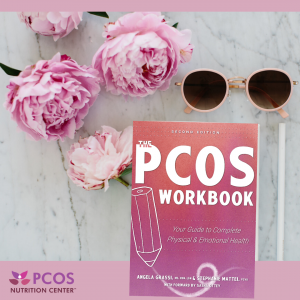[ad_1]
Continuous Glucose Monitors for PCOS may be a new, helpful tool. PCOS affects millions of individuals worldwide, bringing with it a range of challenges, including insulin resistance and elevated blood sugar levels. One estimate shows women with PCOS are at a 4-fold increase risk for developing type 2 diabetes. Managing blood glucose is crucial for individuals with PCOS, and one innovative tool gaining traction in this space is the Continuous Glucose Monitor (CGM). In this blog post, we will explore what CGMs are, how they work, and the pros and cons of using them for managing blood sugar for PCOS.
What are Continuous Glucose Monitors?
Continuous Glucose Monitors are cutting-edge devices designed to provide real-time information about blood glucose levels. Unlike traditional glucose meters that require manual testing several times a day, CGMs offer continuous 24/7 monitoring, allowing individuals to see fluctuations and trends over time. These devices consist of a small sensor placed under the skin, usually on the upper arm, which measures glucose levels in the interstitial fluid.
How Do CGMs Work?
Continuous Glucose Monitors can be used for people with PCOS. A CGM sensor continuously reads glucose levels and sends data to a connected device, typically a smartphone app. Users can access a real-time display of their blood sugar levels, enabling them to make informed decisions about their food, exercise, and overall lifestyle. CGMs offer a more comprehensive understanding of how different factors impact blood glucose, making them particularly valuable for individuals with conditions like PCOS.
Pros of Using CGMs for PCOS:
- Real-Time Insight into Blood Glucose Dynamics: CGMs empower individuals with PCOS to observe in real time how different food combinations or supplements affect their blood glucose levels. This immediate feedback allows for personalized and timely adjustments to dietary choices.
- Detection of Post-Meal and Exercise Blood Sugar Changes: CGMs can reveal whether blood sugar levels drop following a meal or exercise, providing crucial information for managing insulin resistance – a common issue in PCOS. This data helps users tailor their activities and eating habits to maintain more stable blood sugar levels.
- Identification of Overall Blood Sugar Patterns: By using a CGM, someone with PCOS can track continuous glucose levels over time, allowing users to identify patterns in their blood sugar levels at different times of the day, helping them make proactive lifestyle changes to regulate glucose more effectively.
- Early Detection of Blood Glucose Issues: CGMs can aid in the early detection of potential problems with blood glucose, allowing users to seek medical advice promptly and address any emerging issues before they escalate.
Cons of Using CGMs for PCOS:
- Not Covered By Insurance: A significant drawback for individuals with PCOS looking to use CGMs is that, currently, these devices are not covered by insurance unless the user has diabetes. This lack of coverage can be a financial barrier for those seeking to manage their blood sugar effectively.
- Prescription Requirement and Out-of-Pocket Costs: Obtaining a CGM requires a prescription, and users often have to bear the out-of-pocket costs. At around $75 for two sensors, the expenses can add up quickly, making continuous use challenging for some individuals with PCOS.
Veri has an affordable CGM program and has health care providers available to help with obtaining a prescription. Learn more about Veri here.
- Adhesion Issues: CGM sensors can fall off, impacting their effectiveness. Users need to take extra precautions, such as holding the device in place for 30 seconds after application, checking the sensor’s adhesion thoroughly after application, and using covers or arm bands to prevent accidental dislodging. Cleaning the area first and even exfoliating can also help.
- Possible Inaccuracies: CGMs may be off by around 10 points, introducing a margin of error that users should be aware of.
- Risk of Infection: Be sure to clean the area before applying your CGM sensor to reduce the risk of infection.
- Can Become Obsessive: CGMs should only be used a short-term tool to notice blood sugar patterns with food, exercise, supplements or medications. They should not be used long-term unless a medical condition is suspected that warrants its use. Blood glucose levels fluctuate constantly throughout the day, rising and falling continuously. Recommended blood glucose levels are between 70 and 140.
- Not 100% Reliable: Sensors can easily run 15% high or low. So if your actual glucose level is 75mg/dl, the sensor could easily read 65mg/dl. Newly installed sensors are often unreliable for 24 hours. In addition, sensors could run low at night due to low pressure. This is know as “pressure lows.”
CGMs may not be appropriate for individuals with a history of an eating disorder or distorted eating as they have the potential to create hyperfocus with numbers and food. Just because a meal, snack, or food item raises blood sugar, doesn’t mean its harmful for you. CGM use should only be used when working with a health care professional such as a PCOS dietitian.
Does it Hurt to Apply a CGM?
No! The applicator makes it really easy to apply without pain.
Conclusion:
Continuous Glucose Monitors offer a revolutionary approach to managing blood sugar levels for individuals with PCOS. Despite some drawbacks, the real-time insights provided by CGMs can be invaluable for those navigating the challenges of insulin resistance and elevated blood glucose. As technology advances and awareness grows, the hope is that these devices become more accessible, both in terms of insurance coverage and cost, allowing more individuals with PCOS to take control of their health and well-being. Until then, utilizing the tips mentioned can help optimize the effectiveness of CGMs in managing blood sugar levels for those with PCOS.
Share with us: What has been your experience using a CGM for PCOS?
[ad_2]
Source link


